Laying of plumbing in the ground - features of work
When arranging a private house for temporary or permanent residence, it is first necessary to run the water supply system. When it is installed, as a rule, the home plumber’s most challenging thing is the installation of external plumbing. Therefore, below we consider how the water pipe is laid in the ground with his own hands.

General information
When laying pipelines underground laying is everywhere applied.
This is due to several reasons:
- Buried in the ground can not be damaged.
- Lining requires less cost, since there is no need to install special consoles.
- In the ground, the pipes are protected from freezing. (subject to laying to a depth below freezing).
- Plumbing does not spoil the exterior area appearance.
Thus, laying the pipeline in the ground is an advantageous and correct solution.
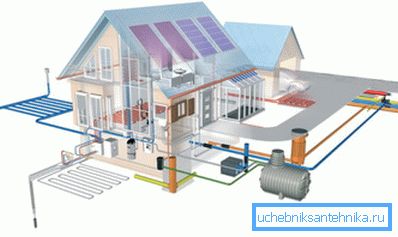
Operating procedure
Project creation
So, if you decide to conduct the water supply underground, first of all you need to complete a project that is designed to solve the following tasks:
- Determines the location of pipes, fittings and other elements of the system.
- Allows you to calculate the cost of materials for plumbing. If the work will be done by workers, then to calculate all the costs, you need to add the cost of laying water in the ground.
- It serves as a work plan, therefore it allows to avoid mistakes in the laying process.
Tip! When choosing the type of pipes, it is better to give preference to plastic, since they are more durable and at the same time their price is lower than steel counterparts.
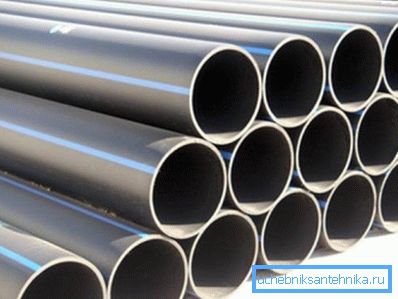
At the design stage, you should decide on the types of pipes, their diameter and other nuances. In particular, you should find out the depth of soil freezing.
Note! From the depth of the trenches will depend on the cost of laying water in the ground per meter, if the work will be engaged in the construction team.
In our country, the depth of freezing is on average 1.4 m. Therefore, it is recommended to lay the water supply system at a depth of at least 1.6 m, otherwise the water may freeze in winter. To find out the exact depth, you can contact any local construction company.
There may also be a problem of land acquisition. To calculate the temporary land acquisition for the period of the water pipeline construction, it is necessary to calculate the total volume of trenches.

Trench preparation
The oldest and easiest way of arranging a street water supply is laying pipes in a trench. Therefore, we consider it below.
So, the task is to dig trenches and properly lay the pipes in them. You can even excavate yourself with an ordinary shovel, especially if the central highway is located nearby.
True, it should be borne in mind that this is a hard and rather long-lasting physical labor. Therefore, the use of construction equipment will greatly simplify and speed up the work. If the soil is hard and stony, then its application may be necessary, as it may not be possible to break through the ground under the water supply system.
The order of work is as follows:
- First you need to dig trenches. Their width depends on the number of pipes laid. As a rule, it is 70-90 centimeters.
- After the trenches are ready, you need to trim their walls and be sure to compact the bottom.
- Next you need to perform a shock absorbing pillow. To do this, the bottom should be filled with a layer of sand 10 cm thick, be sure to shed water and seal well.
This completes the trench preparation.
Installation of water supply
After preparing the trenches, you can proceed directly to the installation of water supply:
- The process of laying and joining pipes and fittings largely depends on the type of material from which the pipes are made. On our portal you can get acquainted in detail with the options for assembling pipelines made from different materials.
- After laying the pipes it is imperative to test the system under a different pressure. Moreover, testing should last for two or three days.
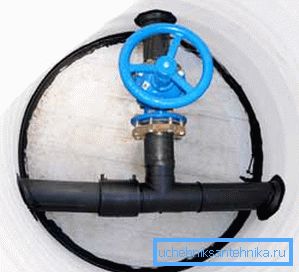
- Near the central highway, as a rule, a well is installed, in which the stop valves are located. The latter allows the emergency shutdown of water, as well as to connect to the water supply of additional objects. The well can be made of reinforced concrete rings, or lay it out of brick.
- Then you need to connect the water supply to the central highway. This work should be done by specialists.
- Next, you need to fill the water supply with sand to 5 centimeters above the highest point of the structure.
- After that, the place of passage of the pipes should be laid with a layer of bat tiles, tiles or bricks.
- At the end of the work, the trench can be covered with earth.
Tip! If running water for the irrigation system, it is not necessary to bury it to a depth below the level of soil freezing, as the system will be used only in the warm season. The only hose for underground water pipes must withstand a negative temperature.
At the same time, the laying of the underground water pipe is completed.
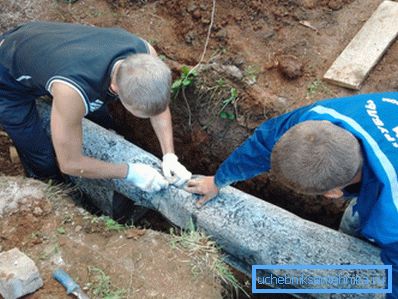
Pipe insulation
It must be said that it is not always possible to arrange the pipes to the required depth. In this case, it is possible to prevent the system from freezing in winter time by warming it.
Currently, there are quite a few types of insulation for pipes:
- Mineral wool;
- Foam shell;
- Polypropylene shell;
- Polyethylene foam, etc.
Anyone and them can handle the task. Therefore, you should focus on the cost of the material and ease of installation.
Tip! Many home masters are interested in - how to find plumbing under the ground? To do this, you can use a thin wire bent letter "G". It should be gently picked up and held as a weather vane, with a long end (about 50 cm) parallel to the ground. With the passage of the highway, the long end will turn in its direction.
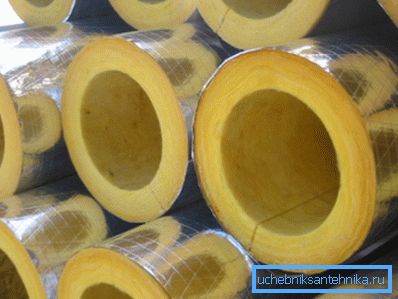
When insulating pipes, it is necessary to protect the insulating material from moisture on it, as well as from squeezing with soil. Therefore, the insulated pipeline is wrapped with a film and protected with a galvanized casing.
Here, perhaps, and all the main points that you need to know to pave the underground water supply.
Conclusion
Laying a water supply system in the ground is nothing complicated. The only thing that the system turned out reliable and worked for many years, you must adhere to the above recommendations.
From the video in this article can be found with additional information on this topic.